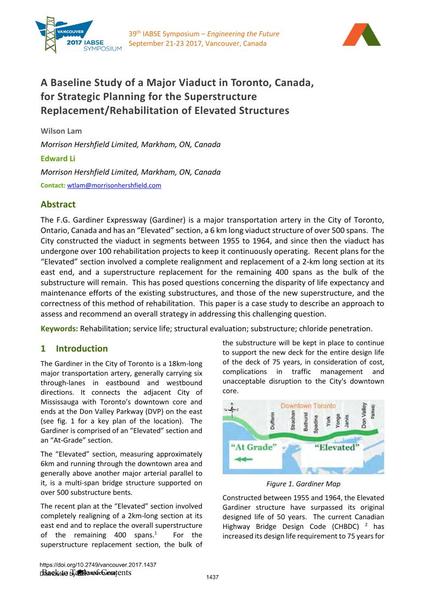A Baseline Study of a Major Viaduct in Toronto, Canada, for Strategic Planning for the Superstructure

|
|
|||||||||||
Bibliographic Details
| Author(s): |
Wilson Lam
(Morrison Hershfield Limited, Markham, ON, Canada)
Edward Li (Morrison Hershfield Limited, Markham, ON, Canada) |
||||
|---|---|---|---|---|---|
| Medium: | conference paper | ||||
| Language(s): | English | ||||
| Conference: | IABSE Symposium: Engineering the Future, Vancouver, Canada, 21-23 September 2017 | ||||
| Published in: | IABSE Symposium Vancouver 2017 | ||||
|
|||||
| Page(s): | 1437-1444 | ||||
| Total no. of pages: | 8 | ||||
| Year: | 2017 | ||||
| DOI: | 10.2749/vancouver.2017.1437 | ||||
| Abstract: |
The F.G. Gardiner Expressway (Gardiner) is a major transportation artery in the City of Toronto, Ontario, Canada and has an “Elevated” section, a 6 km long viaduct structure of over 500 spans. The City constructed the viaduct in segments between 1955 to 1964, and since then the viaduct has undergone over 100 rehabilitation projects to keep it continuously operating. Recent plans for the “Elevated” section involved a complete realignment and replacement of a 2-km long section at its east end, and a superstructure replacement for the remaining 400 spans as the bulk of the substructure will remain. This has posed questions concerning the disparity of life expectancy and maintenance efforts of the existing substructures, and those of the new superstructure, and the correctness of this method of rehabilitation. This paper is a case study to describe an approach to assess and recommend an overall strategy in addressing this challenging question. |
||||
| Keywords: |
service life substructure rehabilitation structural evaluation chloride penetration
|
||||
